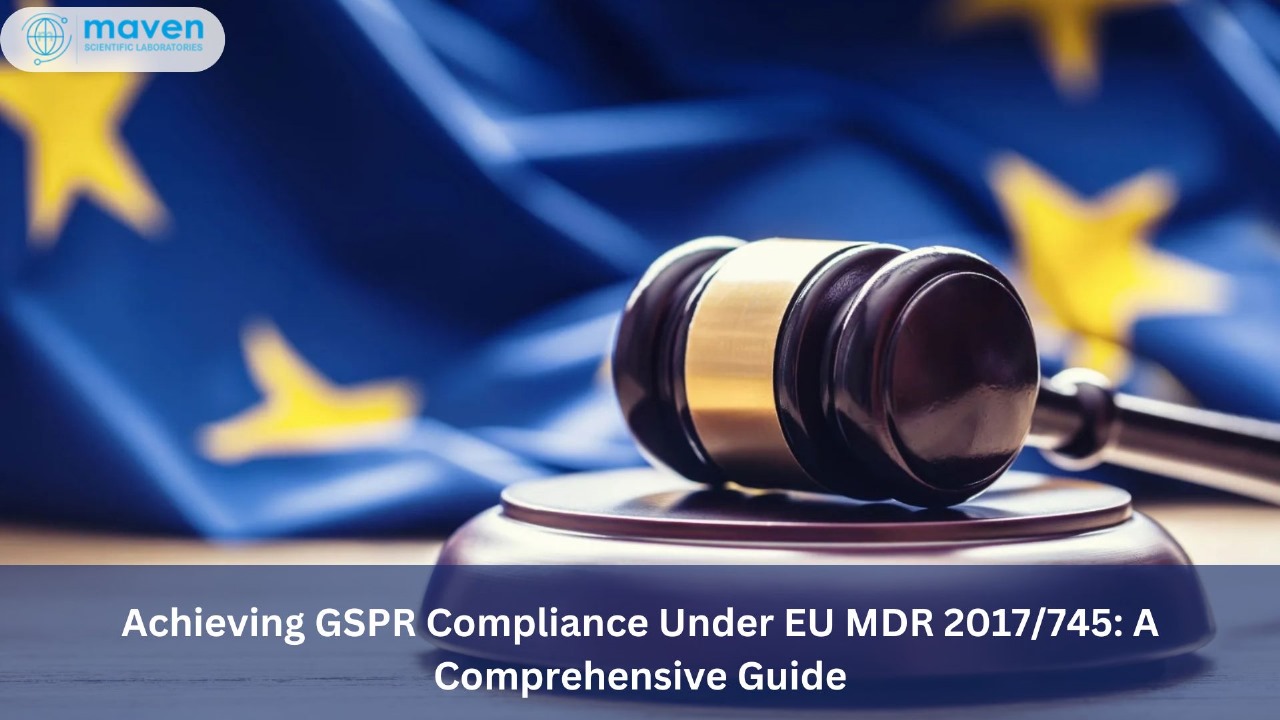
Achieving GSPR Compliance Under EU MDR 2017/745: A Comprehensive Guide
Introduction
The European Medical Device Regulation (EU MDR 2017/745) has introduced stringent requirements for medical device manufacturers to ensure safety and performance. One of the key aspects of compliance is the General Safety and Performance Requirements (GSPR), which replace the Essential Requirements under the previous Medical Device Directive (MDD). Compliance with GSPR is critical for obtaining CE marking and ensuring market access in the European Union.
This article provides a systematic approach to achieving GSPR compliance for medical devices, covering documentation, risk management, clinical evaluation, post-market surveillance, and expert regulatory support.
What is GSPR?
GSPR is outlined in Annex I of the EU MDR 2017/745 and consists of three major sections:
- General Requirements (e.g., risk management, safety, and performance aspects)
- Requirements for Design and Manufacture (e.g., chemical, biological, and physical properties)
- Requirements for Information Supplied with the Device (e.g., labeling and instructions for use)
Each requirement must be met through objective evidence documented in the device’s Technical File or Design Dossier.
Key Steps to Achieve GSPR Compliance
Step 1: Perform a Gap Analysis
A gap analysis helps identify missing or non-compliant elements in the existing documentation. This involves:
- Reviewing current technical documentation against each applicable GSPR requirement.
- Identifying missing evidence or testing data.
- Mapping previous MDD compliance documents to new MDR requirements.
Step 2: Develop a GSPR Compliance Checklist
A structured GSPR checklist serves as a roadmap to compliance. It should include:
- Each GSPR requirement.
- The corresponding justification for compliance.
- References to supporting documentation (clinical evaluation, risk assessment, test reports).
Step 3: Implement a Robust Risk Management Process
Risk management is at the heart of MDR compliance and must follow ISO 14971:2019. The key steps include:
- Identifying hazards related to the device.
- Assessing risks and implementing control measures.
- Maintaining a risk management file with periodic updates.
Step 4: Ensure Biocompatibility and Chemical Safety Compliance
Medical devices must meet biological safety standards as per ISO 10993. The compliance process involves:
- Conducting biocompatibility testing.
- Assessing potential leachables and extractables.
- Ensuring material safety through toxicological evaluations.
Step 5: Conduct Clinical Evaluation and Performance Testing
Under MDR, a robust Clinical Evaluation Report (CER) is mandatory, aligned with MEDDEV 2.7/1 Rev. 4. Manufacturers should:
- Gather clinical data through studies or literature reviews.
- Demonstrate equivalence to an existing device (if applicable).
- Validate performance and safety via post-market surveillance (PMS) plans.
Step 6: Maintain Post-Market Surveillance (PMS) and Vigilance Systems
A strong PMS and vigilance system ensures continuous compliance. Manufacturers must:
- Develop a Post-Market Surveillance Plan.
- Regularly update the Periodic Safety Update Report (PSUR).
- Report incidents and corrective actions in compliance with MDR vigilance requirements.
Step 7: Compile and Review Technical Documentation
All supporting documents should be compiled into a Technical File or Design Dossier. This should include:
- GSPR Checklist.
- Risk management documentation.
- Clinical Evaluation Report.
- Labeling and IFU compliance evidence.
- Biocompatibility and performance test results.
Challenges in Achieving GSPR Compliance
1. Increased Documentation Requirements
The MDR requires extensive technical documentation, which can be overwhelming for manufacturers.
2. Complex Clinical Data Requirements
Gathering sufficient clinical evidence and demonstrating equivalence is more stringent than under MDD.
3. Evolving Regulatory Expectations
Continuous updates and interpretations of MDR requirements create compliance uncertainties.
4. Post-Market Surveillance (PMS) Burden
The need for real-world data collection, proactive safety monitoring, and timely PSUR submissions increases the regulatory burden.
5. Time and Resource Constraints
Compliance efforts require dedicated regulatory expertise and significant time investments, which can delay market entry.
Best Practices to Streamline GSPR Compliance
Develop a Robust GSPR Compliance Strategy
Establish a comprehensive strategy that outlines the approach to meeting GSPR requirements, including timelines, resource allocation, and responsibilities.
Follow a Detailed GSPR Checklist
Utilize a detailed GSPR checklist to track compliance efforts and provide a clear overview of the compliance status for each requirement.
Align with EU MDR GSPR Guidelines
Ensure all compliance activities align with the EU MDR 2017/745 guidelines.
Document GSPR MDR Requirements Effectively
Maintain thorough and organized documentation for all GSPR-related activities to support regulatory submissions and audits.
Integrate Risk Management and Usability Assessments
Incorporate risk management and usability assessments into the compliance strategy to identify potential hazards and ensure user safety.
Ensure Post-Market Surveillance for GSPR Compliance
Implement a robust post-market surveillance system to monitor product performance and safety after release.
How Maven Can Support Your GSPR Compliance Journey
Navigating GSPR compliance can be complex, but Maven offers expert regulatory support to simplify the process. Our services include:
- Gap Analysis & Compliance Strategy: Identifying missing elements and developing a clear action plan.
- GSPR Documentation Support: Creating structured GSPR checklists and compiling technical files.
- Risk Management & Biocompatibility Assessments: Ensuring compliance with ISO 14971 and ISO 10993.
- Clinical Evaluation Reports (CER) Development: Assisting in clinical data collection, literature reviews, and performance evaluation.
- Post-Market Surveillance & Vigilance Support: Developing PMS plans, PSURs, and incident reporting systems.
By partnering with Maven, manufacturers can confidently meet the EU MDR 2017/745 requirements, ensuring compliance, safety, and market access with ease.
Conclusion
Achieving GSPR compliance as per the EU MDR 2017/745 is a critical step for medical device manufacturers aiming to market their products in the European Union. By following a structured approach, adhering to best practices, and utilizing expert guidance, manufacturers can navigate the complexities of GSPR requirements and ensure that their devices are safe, effective, and compliant with regulatory standards.
For expert assistance in GSPR documentation, compliance gap assessments, or technical file compilation, contact Maven today!







